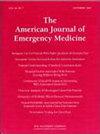Perceptions and patterns of Cannabis use in emergency department patients following recreational legalization in Massachusetts
IF 2.7
3区 医学
Q1 EMERGENCY MEDICINE
引用次数: 0
Abstract
Introduction
In Massachusetts, cannabis was legalized for recreational use in 2016. Legalization was associated with an increase in cannabis-related emergency department (ED) visits. The purpose of this study was to characterize cannabis use in an ED population in Massachusetts following legalization.
Methods
This was a convenience sample survey study conducted at an academic medical center ED in Massachusetts. Patients aged 18 or older reporting cannabis use within the last month were eligible. Participants were surveyed about cannabis use including: use patterns, risks and benefits, concomitant substance use, and changes in use post-legalization. Patients and treating physicians were asked whether ED visits were attributable to cannabis to determine discordance. Data analysis used descriptive statistics.
Results
Between July 2019 and May 2021, 200 patients were enrolled. Relaxation and analgesia were the most common reported benefits of cannabis. 46 % of patients prescribed an opioid reported decreased opioid use due to cannabis. 31 % reported no perceived risks from cannabis, and 22 % believed cannabis impaired driving. Twenty-one patients presented with a cannabis-related chief complaint per the treating physician; 11 (52.4 %) believed their presentation was due to cannabis. Post-legalization, 28.5 % of patients reported increased cannabis use.
Conclusion
In this study of patients with cannabis use presenting to a Massachusetts ED, the majority did not report increased use following recreational legalization. Patients reported multiple benefits of cannabis, including decreased opioid use, but minimized risks including intoxicated driving. Almost half of patients with cannabis-related symptoms did not attribute them to cannabis. These findings may inform harm-reduction strategies.
麻萨诸塞州娱乐性大麻合法化后急诊科患者大麻使用的认知和模式
在马萨诸塞州,大麻于2016年合法用于娱乐用途。大麻合法化与大麻相关急诊科(ED)访问量的增加有关。本研究的目的是表征大麻在麻萨诸塞州大麻合法化后ED人群的使用情况。方法本研究是在马萨诸塞州的一个学术医学中心进行的方便抽样调查研究。在过去一个月内报告使用大麻的18岁或以上的患者符合条件。对参与者进行了关于大麻使用的调查,包括:使用模式、风险和益处、伴随物质使用以及大麻合法化后使用的变化。患者和治疗医生被问及是否急诊室就诊可归因于大麻,以确定不一致。数据分析采用描述性统计。结果在2019年7月至2021年5月期间,纳入了200名患者。放松和镇痛是大麻最常见的益处。处方阿片类药物的患者中有46%报告说,由于使用大麻,阿片类药物的使用减少了。31%的人表示大麻没有感知到风险,22%的人认为大麻会损害驾驶。每名主治医生有21名患者提出与大麻相关的主诉;11人(52.4%)认为他们的表现是由于大麻。大麻合法化后,28.5%的患者报告大麻使用量增加。结论:在这项研究中,麻州急诊科的大麻使用患者中,大多数人在娱乐性大麻合法化后并没有报告大麻使用增加。患者报告了大麻的多种益处,包括减少阿片类药物的使用,但将包括醉酒驾驶在内的风险降至最低。几乎一半有大麻相关症状的患者没有将其归因于大麻。这些发现可能为减少危害的策略提供信息。
本文章由计算机程序翻译,如有差异,请以英文原文为准。
求助全文
约1分钟内获得全文
求助全文
来源期刊
CiteScore
6.00
自引率
5.60%
发文量
730
审稿时长
42 days
期刊介绍:
A distinctive blend of practicality and scholarliness makes the American Journal of Emergency Medicine a key source for information on emergency medical care. Covering all activities concerned with emergency medicine, it is the journal to turn to for information to help increase the ability to understand, recognize and treat emergency conditions. Issues contain clinical articles, case reports, review articles, editorials, international notes, book reviews and more.

 求助内容:
求助内容: 应助结果提醒方式:
应助结果提醒方式:


